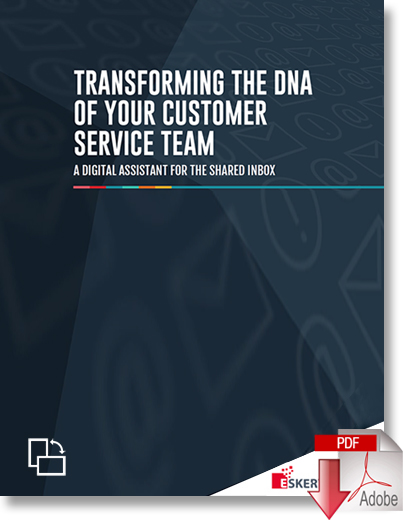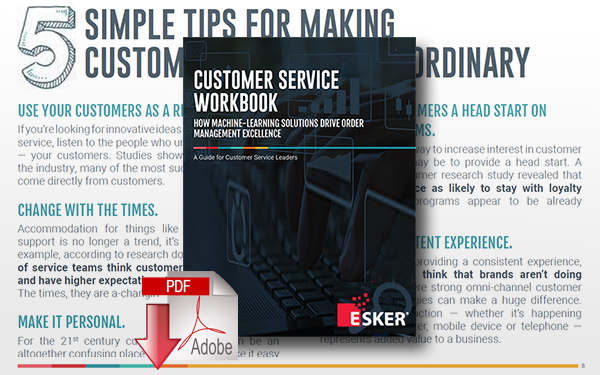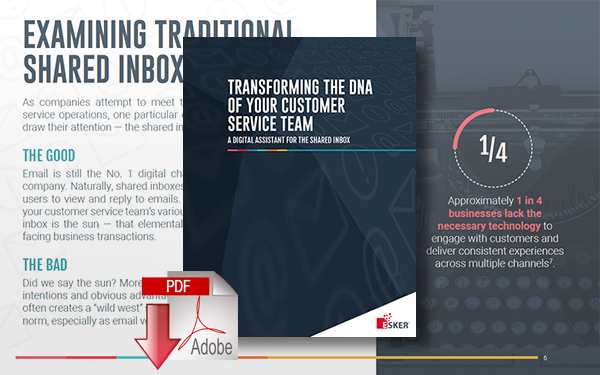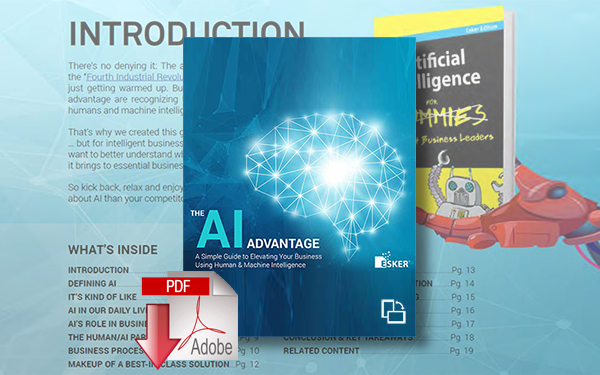How Automation Makes Handling Customer Inquiries Easy to Achieve With a Digital Assistant

Many of today’s modern enterprises are stuck having at least one full-time employee who lives and breathes the central email box, and their job is solely to open every email that comes into the enterprise and try to figure out what exactly the customer might be asking for.
How Automation Makes Handling Customer Inquiries a Piece of Cake
Many of today’s customer service (CS) teams are making do with tedious processes that still consist of emailing PDFs and other customer inquiries back and forth within the organization to be opened, read, and manually re-entered.
The average CS team receives thousands of customer orders, inquiries, product questions, requests for quotations, status requests, disputes, and supporting documentation emails monthly.
Often, customer service requires dedicated employees that spend their day “triaging” where orders and inquiries need to be routed due to the manual nature of the process.
The person in charge of the triage must classify the requests into different categories, then route them to the appropriate service or person, such as product-related questions may be sent to product management, quotation requests routed to sales, claims can be sent to logistics or accounts receivable team, and so on.
As customer inquiries management directly impacts customer satisfaction, the customer service department needs to follow up on those inquiries and ensure they are addressed quickly.
Unfortunately, between constantly monitoring the team email inbox and manually triaging where customer requests are sent, the process is broken.
However, because orders are still flowing in, organizations may view the manual process as “good enough” and not as a cost-saving priority - resulting in a missed opportunity to:
- Increase team efficiency with fewer errors. Things like erroneous information and duplicate documents only cause delays, and no customer is interested in hearing excuses why you didn’t process their order or respond to their quote request. With automation, you can figure out which inquiry types are the most frequent and quickly put in place actions to address them and your most time-consuming customers.
- Provide greater customer satisfaction due to faster routing times. Customer inquiries automation allows suppliers to address customer inquiries faster thanks to AI-driven automation, which helps classify and route requests received by email. In addition, suppliers can quickly identify areas of improvement by accessing metrics and charts that oversee the customer inquiries process.
- Improve working capital by getting orders processed faster. While your internal costs of doing business may not be important to your customers, there’s no denying that cost-efficient business processes lead to improved productivity and better performance in every department, especially in customer service. Simply put: You get paid faster when orders are processed and fulfilled quicker and more accurately.
How It Works Within an AI-Powered Customer Service Team
A customer service representative (CSR) manually classifies the first inquiries, and after seeing a few examples of a given category, the AI engine will automatically categorize each inquiry, getting more and more accurate along the way. Orders can automatically be identified in the email flow and routed appropriately. Similarly, order questions can be routed as conversations on the related order, using the PO number to link the inquiry with the order.
Other inquiry types can be routed by email to any email address, and the email recipients can then answer those inquiries directly from their mail application as usual, without even knowing that the customer email was classified and routed via Esker’s solution. All inquiries are tracked through dashboard KPIs, and reports enable customer service managers to analyze customer inquiries by category, date, customer, etc.
That means fewer resources spent manually pushing customer documents around and less time wasted trying to work with disparate systems. Instead, focus on what’s most important - serving your customers.
Unfortunately, many of today’s modern enterprises are still stuck having at least one full-time employee (FTE) who lives and breathes the central email box. Their job is solely to open every email that comes into the enterprise and try to figure out what exactly the customer might be asking for.
From there, they have to flag emails, sift out the mission-critical stuff, reroute things that aren’t relevant, and then ultimately interact with the customer or delegate messages to people who can better address their needs.
Imagine if you had one extra FTE back on your team … How might that impact your customers and your staff’s work experience? How could it benefit your bottom line?
A New Standard in Customer Service
There’s been a shift in customer behavior, but it’s not the only active fault line upon which the foundation of traditional customer service sits. As businesses compete to differentiate themselves in a post-pandemic digital landscape, they too are forging new paths of perspective.
As a result, customer service - once merely a cost center with transactional problem-solving being its primary function - is increasingly being looked to as a value-generating operation capable of shaping the end-to-end customer experience (CX) and driving long-term business growth. This new, more resilient set of priorities includes an increased focus on:
Proactive service > reactive service
Reactive customer service is like a bandage: It stops the bleeding but doesn’t prevent injury. It’s why proactive strategies - often powered by tech such as AI - are playing a major role in increasing customer retention and satisfaction.
Convenience and personalization
Over 60% of customers would defect to a competitor after just one bad experience. Knowing this, many businesses are centralizing communications so that convenient and personalized CX is ensured, regardless of what CSR is available or who responds.
Employee empowerment
Lack of meaningful work is a big reason 70% of employees are actively considering quitting their jobs. Today, the happiest CSRs spend the bulk of their time on tasks that are as fulfilling as they are impactful (e.g., upselling, cross-selling, etc.).
Lower cost-to-serve
In case we’d forgotten, the pandemic gave us all a rather rude reminder: Cash is still king. Yes, lowering cost-to-serve was always a priority, but as businesses look to seize on new opportunities for innovation and profitability, it’s fast becoming The Priority.
The Benefits of Hiring a Digital Assistant (aka Automating Customer Inquiries)
Customer inquiry management automation is the perfect complement for customer service teams transitioning from a cost center to a value center. Acting as a digital assistant, automated solutions clean up the mess of traditional shared inboxes, resulting in a faster, more strategic process that enables continuous improvement and aligns with the motivations of every stakeholder.
With AI-driven tools for inquiry classification, email routing, collaborating, and tracking at their disposal, your team has everything they need to proactively serve customers and provide a greater value to the company:
- Instant access to key information regarding customer inquiries
- Reduced stress by enabling any CSR to handle any request
- More time to dedicate to activities that generate real business value
- Better insight into CSR workload and performance trends
Are You Ready to Make Your Transformation?
Get all the details on customer inquiries management automation in this info-packed ebook; Transforming the DNA of Your Customer Service Team: A Digital Assistant for the Shared Inbox
About the Author
Diana Eagen is the Director of Sales for order-to-cash solutions at Esker North America. Diana’s expertise is in providing software that complements an organization's Customer Service, Finance, and IT departments while improving their productivity, efficiency, and environmental impact. Her passion at Esker is eliminating manual processes to decrease customer costs within the order management process.
Related Resources
How Machine-Learning Solutions Drive Order Management Excellence
Download this Customer Service Workbook to discover industry tips and best practices for bringing efficiency and profitability to order management while freeing up your Corporate Social Responsibilities. Download Now!
Transforming the DNA of Your Customer Service Team - a Digital Assistant for the Shared Inbox
This ebook attempts to answer questions by examining recent customer service trends, addressing the elephant in the room (shared inboxes), and exploring the benefits of employing a digital assistant to help your customer service reps work smarter, not harder. Download Now!
The AI Advantage
Businesses eager to create a competitive advantage are recognizing that the future is at the intersection of humans and machine intelligence, and that's where this guidebook helps. Download Now!
More Resources from Esker
Related Article: The Future of Process Automation will be Driven by AI Not Bots
Article Topics
Esker News & Resources
Supplier Management Automation 5 Interesting Facts About Automation Technology Accounts Receivable Automation Using Artificial Intelligence Rethinking Receivables 4 Reasons Supply Chain Leaders Are Investing in Order Management Automation Solutions Optimizing Cash Flow Automation in the Age of Uncertainty Supply Chain Automation: Optimizing Cash Flow in the Age of Uncertainty More EskerLatest in Supply Chain
TIm Cook Says Apple Plans to Increase Investments in Vietnam Amazon Logistics’ Growth Shakes Up Shipping Industry in 2023 Spotlight Startup: Cart.com is Reimagining Logistics Walmart and Swisslog Expand Partnership with New Texas Facility Nissan Channels Tesla With Its Latest Manufacturing Process Taking Stock of Today’s Robotics Market and What the Future Holds U.S. Manufacturing Gains Momentum After Another Strong Month More Supply Chain


















